Beast Codex
|
Native species |
Alien species |
Native Europa Species
Unicorn
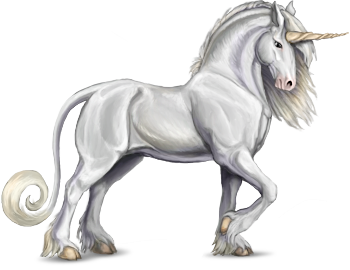
Species-specific genes
- Magic horn
- Determined
- Scholar
- Gracefulness
- Regeneration
- Fragrance
- Magic mirror
Average size

At first its almost like seeing a ghost. There are half a dozen of them standing by the stream, with wispy manes and spiraling horns that catch the sun. Despite their large size, their hoof beats go unheard on the grassy meadows, which is more than you can say for your clumsy footsteps. However, they haven’t seemed to notice you yet, or if they have, they’ve deemed you unworthy of their attention. Hoping to get a closer look, you ease down the slope, using branches to catch yourself. Still, the recent rains have left the ground slick with mud, and it isn’t long before you lose your footing. With a painful yelp, you slide down the embankment to the rotting leaves below. There is a moment where you feel almost embarrassed as the creatures shift their eyes to you, but a moment later they’re gone, vanishing into the woods without a sound.
Seeing one for the first time is like a dream. While similar in build and strength to the draft horses, they are undeniably separate creatures. Despite the name unicorn which literally means ‘one horn’, their horn is actually made up of two separate ones that have spiraled and fused together to create one. These horns hold many properties, and while there was once a market for ground unicorn horn, society has realized the unicorns hold more value alive and happy.
Perhaps the most valuable of the unicorns traits is the powerful healing ability within these horns, where unicorns may create an antiseptic secretion. The horns are also made from a highly reflective material, allowing unicorns to angle their heads and blind their enemies with directed beams of light. While the abilities and strength may vary individual to individual, gender of the Unicorns hold no effect on the abilities generated, nor the size of the horns. (However, the largest horn known to date belonged to Massive Maddy, a female Okapi unicorn with a horn at a whopping 19 inches).
Primarily used as horses are on Earth, these beautiful creatures are frequently seen in all walks of life on Europa. Useful in travel and in war, lavishly decorated Unicorns can be seen as the subject for various festivals and ceremonies. Lords are known to pay elaborate amounts of money for a well-bred Unicorn to ride into battle, as these beasts are known for their synergy with their riders. They’re also known for their calm natures, and are very predictable as chargers, making them well-trusted steeds on the war front.
A Unicorn’s horn is considered the most important feature, both for its healing properties and as a weapon on the battle field. While body balance, muscles and behavior are valuable to breeders, it’s the horn breeders tend to keep their eye on. Length as well as durability are taken into account, as well as the bend of the horn - or rather, the lack thereof. Straightened horns are preferred over those that may turn to either side, as those are more likely to break in battle.
Coming in a variety of colors, the pure white of the mythical unicorns continues to be the preferred in domesticated Unicorns. This coloring gives these quick, graceful creatures the appearance of a ghost, which can be daunting in battle. Indeed, there are many legends surrounding a Unicorn and its spectral rider. Creatures of beauty and power, Unicorns serve their owners perhaps beyond deserving.
Gryphon

Species-specific genes
- Musical beak
- Berserker
- Spurs
- Gracefulness
- Lionheart
- Second breath
- Gladiator
- Sharp feathers
Average size

Ahead in the woods, the creature is vanishing out of sight, a lengthy, fur-tipped tail whipping behind it. For a moment you can only consider, trying to match the brief glimpse you got with some animal in your mind - perhaps an albino lion? Yet, the sound you heard earlier was like the screech of a falcon. Even when the thing circles back around and you catch a glimpse of the head it takes a moment to click. It clacks its beak at you, ears pulled forward like some kind of large dog.
Perhaps a modification on the massive Roc, Gryphons are a charming, chimeric creature, a half and half mix between an avian and a predatorial mammal. While they resemble felines in many aspects, they are remarkably canine in their behavior. Powerfully loyal, they have a sworn allegiance to Man and are tireless in this aspect. It’s said that a gryphon may go to the ends of the earth for their masters, and being fierce warriors will face death to protect others. Still, with the wings and claws of a massive bird and the intelligence of a well-trained dog, Gryphons are unlikely to go down in a fight. Put to use as guard dogs, patrollers and even within the Army, Gryphons rarely faltered in battle and will take on any opponent with eager paces.
Gryphons are also surprisingly popular as house pets, although rarely affordable. Playful creatures at heart, they are happy to engage in games with their owners, and are wonderfully careful with children. Protective of their homes, Gryphons make fantastic baby sitters, capable of entertaining children as well as making sure they stay safe. They’re relatively easy to care for, with a wide diet of meat, vegetables and everything in between. Those living in the more wild oriented homes may find Gryphons more than capable of feeding themselves. Unfortunately, Gryphons are also easily convinced that their owners need caring for as well, and are known to drag ‘food’ into the yard or even onto the porch. These attempts at gift-giving should be handled gracefully, as these curious hybrids may take offense when their presents are rejected.
The appearances of gryphons vary wildly, from stately black feathers to a mottled mix of striped wings and spectacle like markings around the eyes. While clearly a hybrid beast, it can be difficult to tell where the bird ends and the beast begins. Loyal, fearless creatures, a Gryphon makes an excellent addition to any family. They’re surprisingly curious, getting into all sorts of trouble but fortunately having more than enough capability to handle it. Still, a family may want to set down guidelines early on to prevent gryphons from tearing up the garden...
Dragon
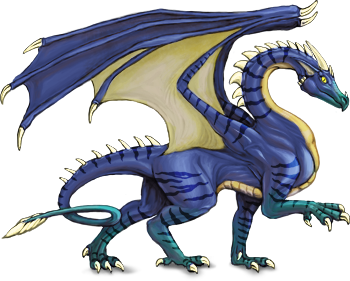
Species-specific genes
- Fire gland
- Fearsome look
- Artisan
- Spitting muscle
- Boiling blood
- Second breath
- Napalm gland
- Robust scales
Average size

The land is nearly a waste. The ground has become barren, dirt coated with a thin layer of ash and grass stubble like charcoal. Trees, or at least what is left of them, are stark black sticks against the skyline. To your left are great boulders, the start of the mountain range that creeps ahead of you. The one underneath your hand is still warm, and it's then you realize that the bright gold thing isn't a hunk of amber but an eye, and the eye is looking at you.
As you stagger back, the ground shifts and the thing unfolds, wings spreading to block your vision. You have one thought before a stream of fire emerges from the creature's gullet. Dragon.
Early in the development of life on Europa, pioneers found the need for ways to quickly transport supplies. Using creatures of reptilian nature, Mages were able to engineer the first Dragons. With great, strong wings and scales able to withstand even the highest temperatures capable on Europa, dragons were a useful addition to life. Many were used to help shift supplies from colony to colony, as well as act as guardians between rival groups. Dragons also boast an affinity for detecting precious metals in the earth, using powerful, clawed feet to dig at the earth and shift aside large stones.
Situated at the roof of the mouth and at the top of the throat are special glands, contained a highly unstable liquid that, when in contact with oxygen, creates a burst of fire. Using a specific group of muscles in the throat, dragons may spit this liquid out at high speeds and with deadly accuracy. In the past this fire has been used to clear territory to allow for building, as well as a use in melting down ores.
Over time, society began to split and fight for dwindling resources, as well as the more heavily desired territories throughout the land. Dragons were heavy players within this, their rock hard scales deflecting simple weapons, their fire capable of mass destruction in minutes. These great beasts continue to defend their masters to this day, although many have gone to the mountains, creating massive caverns and hoarding the ores they have grown to value so much.
Like many reptiles, dragons do enjoy sprawling out on a warmed stone and resting in the sun. Some have even been seen rolling over to expose their bellies, where the scales aren’t as like armor. Quiet creatures, they spend most of their time dozing, as it takes plenty of energy for the reptiles to carry their own weight. Some blend cleverly with the mountain scenery, while others boast bold markings across their hide. Meat eaters by nature, they are even known to fish by trailing their tails in pools of water to act as a lure before snapping them up with quick head movements. Unlike most reptiles, dragons have slender ears along the horns at the crown of their head, but like most lizards base their sense of smell on their tongue.
While there is no recorded case of a dragon engaging in highly intelligent behavior, many believe them to be fairly clever. Capable of manipulating others and solving puzzles as well as creating basic structures, cults throughout Europa believe that dragons will someday rise up as overlords and rule Europa for themselves.
Cockatrice

Species-specific genes
- Poisonous teeth
- Acid gland
- Petrifying gaze
- Bet Expert
- Poisonous claws
- Spitting muscle
- Regeneration
- Stench
- Venomous skin
Average size
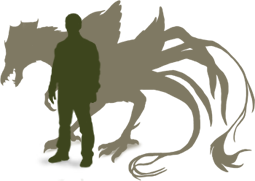
As the creature crosses the terrain ahead of you, its head bobs with every movement, almost like a chicken. But chickens aren’t as tall as you are, and chickens don’t have talons that look like they could take your hand off. You’re fairly sure you’re safe in the foliage, at least until it turns its head, pausing. The intelligence in its eyes is unmistakable, but as it catches your gaze you can sense the feeling losing your fingers.
You have fallen victim to the stare of the Cockatrice.
Almost everything about these bizarre creatures is in some way venomous. From their scales to their blood, Cockatrices are useless as food due to their high toxicity. Brutal hunters, Cockatrices can move quickly, relying on acidic spit to attack from a distance. Scientists have had difficulty creating antidotes and resistance potions for the effects Cockatrice venom has, due to the ever-changing qualities. The very cell processes of their bodies are prone to change, allowing them to adapt to multiple environments, and Cockatrices have been observed altering their chemical compounds in different climates.
The cock-like comb at the top of their head is used to regulate blood flow and internal temperatures, as well as taking part in their mating rituals. Cockatrices also boast long, elegant feathers used to attract mates. Although fairly pack oriented in their hunting behaviors, Cockatrices are rather solitary for the most part. While these creatures bear wings, they are incapable of true flight but have been known to use their wings to help run up inclines and cliff faces without trouble.
Perhaps the most intriguing feature of the Cockatrice is what has been dubbed by natives as the Petrifying Gaze. Animals have been witnessed freezing after being spotted by the Cockatrice, and while they show no outward injury or sign of contact with the Cockatrice’s acidic attacks, the creatures made no attempt to escape this deadly predator. The effect seems to come into place after meeting the gaze of a Cockatrice, but of course no one has survived such an encounter with a feral Cockatrice to study upon it further. Scientists believe Cockatrices may possess certain biokinetic abilities that allow them to control the nervous systems of creatures near them, but as Cocktrices are unwilling to display this ability on command it has been impossible to determine for sure.
For the most part Cockatrices seem fairly intelligent and with a great will to survive, but integrating them into society has proved difficult. Feral creatures at heart despite their background, Cockatrices are tricky to handle at best and should be only approached by experts.
Puma
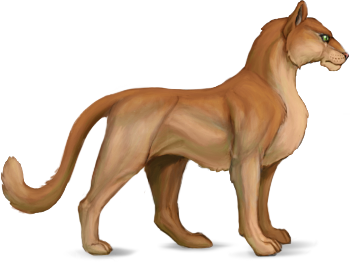
Species-specific genes
- Saber-toothed
- Musical larynx
- Berserker
- Silent pace
- Gracefulness
- Lionheart
- Second breath
Average size

You spot the beast sprawled out across the rock, lightly spotted coat presenting a sheen in the sun. It hasn’t seemed to notice you yet, and looking at those large paws you can’t help but be grateful of that. It reminds you vaguely of the house cats from back home, but much larger. Much, much larger … Deciding it might be best to head out, you turn to walk back the way you came. You are greeted by the thud of paws on dirt, and eyes that look bizarrely intelligent. It seems there was more than one these great cats - the Puma.
While similar to the domesticated cat in many ways, Pumas are unmistakably not cats. Some stand as tall as a man, their coats varying from simple beige to spots and stripes, and are considered highly decorative creatures in many households. While originally a luxury pet for rich aristocrats, these graceful creatures populate the wild as well, and are highly independent. With large paws and a lengthened neck, Pumas are expert hunters, preferring tactics in ambush over face to face confrontation. They’re also known to climb trees and spring down from branches, knocking their prey to the ground and snapping their necks. Pumas prefer to finish fights in as little moves as possible, aiming for the fragile throat as frequently as possible.
Yet, if cornered, Pumas are surprisingly fierce. In a panic, Pumas will go berserk, using their powerful paws to fight back. Even in a dangerous, enclosed situation, Pumas are typically the victor in all their battles. Popular among military areas, Pumas are used for reconnaissance expeditions, assassinations, and various stealth missions. Deadly and silent, they are a force to be reckoned with, which is almost funny considering their background as high class pets.
Ill-suited for life in a luxury flat, Pumas need large spaces to roam and prefer many landings off the ground to give them room to exercise their jumping abilities. Unlike Unicorns and Gryphons, they feature a strictly carnivorous diet, and lots of it. In the wild, Pumas can be found most anywhere save the desert, although canyons are a beloved habitat for the sandy colored variety. In the jungles they can be seen lurking among the undergrowth and amongst the sprawling branches of massive trees. But then, Pumas are rarely seen in the wild, due to their quiet nature and ease in the shadows. At least, not before it’s much too late.
Roc

Species-specific genes
- Musical beak
- Steel beak
- Watchman
- Spurs
- Massive wings
- Electric gland
- Sharp feathers
Average size

From a distance, it appears almost as a dragon. Wings spread for many feet, leaving a shadow across the ground. The creature is rapidly approaching, and the scream is almost deafening, echoing far across the rocky terrain. Fortunately it hasn’t spotted you, but with terrifying speed it advances on some other creature. In seconds it has snatched up the poor thing in talons as lengthy as swords, carrying it off into the mountains. Perhaps it’s best for you to clear out before it comes back …
The Roc is yet another byproduct of genetic engineering. Resembling hawks of a gargantuan size, Rocs are built for speed. They boast incredible intelligence, using sharp talons to dig at the earth and flip over stones where prey may hide. However, perhaps most remarkable are the glands located along their throat. Natural generators of electrical energy, Rocs use beaks made of steel along with sets of paper-thin, steel edged feathers to conduct this electricity through their body to use in attack. As Rocs fly, the movement of their wings generate friction, creating static currents that can prove deadly if interfered with.
Living generators, Rocs require few resources to survive, eating prey creatures naturally found on Europa. Rocs may be trained in use as a generator, and when hooked up correctly energy can be siphoned from their bodies to be stored in batteries and put to practical use. After targeting their prey with keen eyes, Rocs may drop like a stone to earth and stun or even kill with a burst of electrical energy. With their use of electricity in offense and defense within a battle, Rocs have frequently been referred to as Thunderbirds.
Rocs have also been known to be employed as scouts, the large birds circling high overhead or flying rapidly through an enemy's territory to collect information. Highly intelligent and with a good memory for numbers, Rocs have proved highly useful in the past. Others put these great birds to use for exploration, sending the birds out to find land across the sea or to scout out unexplored terrain for possible settling areas. Fairly territorial, it is unwise to keep more than one Roc in a small area. Competing Rocs are known to cause currents that mimic thunderstorms, creating a highly unstable environment. Still, a single Roc makes a great addition to the community, providing both a generator and a fierce fighter.
Alien Species
Symurgh

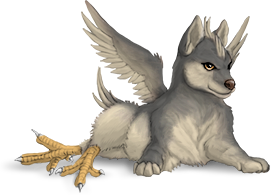
Half-canine and half-avian, she is a quintessence of life and prosperity, fascinating the people with grace and mesmerizing colors. It's a giant creature that is big enough to deal with a Dragon - the size of Symurgh is close to that of an adult Roc. Nobility and dignity are essential parts of her nature, so before she decides to help you, you'll need to convince her that you're worthy of her. Her natural powers are fertility, purification and regeneration.
The native world of Symurghs is Io. They prefer abundant mountain landscapes with open water sources like rivers, ponds and waterfalls. The ecosystem and Symurgh live in symbiosis: the land provides Symurgh with everything it needs while the animal increases the fertility of nearby lands being a source of a specific aura which affects all protein life forms. The initial research group discovered that this "aura" is actually a very generic type of pheromones that affect the process of cell division, making it more stable, and increases the speed of metabolism. This improves immunity, helps to recover from wounds and produce crops and offsprings faster than usual. The Mages suppose that Symurgh developed this property naturally because of the huge amount of food required to support such a large creature on a planet with scarce resources. Somehow they need to support the area where they live, or it would be devastated.
Species-specific genes |
||
|---|---|---|
| Title | Gene Group | Effect |
| Song of Peace | Jaws | Your opponent can't go berserk in face-to-face battle. You can automatically win one battle in Explore; such win doesn't give any XP and you can't defeat a Temple Guardian with this ability. You have 2 additional points for defense roll on the Tactic Map. |
| Musical Larynx | Jaws | On every attack there is a 20% chance that your opponent will miss the turn. Deaf and Determined opponents ignore your howling. Opponents with Poor Hearing have 20% chance to resist your howling. |
| Sense of Direction | Sense Organs | You always choose the zone that is closer to bonuses when retreating on the Tactic Map. |
| Determined | Brain | Immune to shriek, roar, petrify, frighten, blind effects. Delays the discipline weakening by 1 cycle on the Tactic Map if there are 2 or more Determined pets in the squad. |
| Paws Memory | Paws | You deal +50% damage when repeating the previous maneuver in face-to-face battle. The maximum of 2 maneuvers instead of 3 will be re-rolled if the squad has 2 or more pets with Paws Memory. |
| Fertility | Muscles | You have twice more breedings available. Females have a 50% chance to give birth to twins. |
| Regeneration | Internal Organs | Your wounds are healing before your very eyes. You regenerate 15% of your Hitpoints every turn. |
| Fragrance | Skin | Your pet produces a pleasant odour. Dodge chance is increased by 75%. |
| Salt of the Earth | Bones | Constitution is increased by 70%. |
Throdama
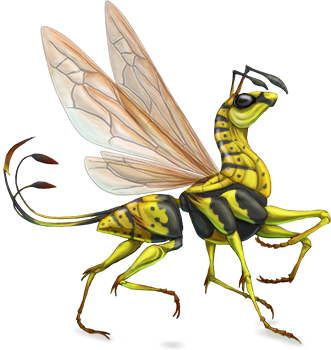

Throdamas are social insect-like creatures from Ganymede. The name of this graceful yet deadly creature originates from the long forgotten language of our ancestors and means "jointed doe". A colony of Throdamas is called a Hive. Solitary Throdamas are self-sufficient and capable of independent living. Like many other gigantic animal species, the ancestors of Throdamas were created artificially by the human kind to help in the exploration and mastering of the alien worlds. Great strength provided by big size and advanced intelligence made them irreplaceable for the mine works, scouting, foraging and defending the human settlements and bases on Ganymede. Although the human civilization has disappeared leaving Ganymede a quite harsh place to live. Throdamas continued their evolution developing different kinds of forms and successfully taking many ecological niches without humans. Our research group has found five morphs of Throdamas.
Morphs and specialization |
||
|---|---|---|
| Morph | Description | Morph features |
 Worker |
The most widespread and the only morph that is able to reproduce and care for young. Their behavioral patterns somewhat resemble the Earth wasps or ants who demonstrate some outstanding examples of well-organized and effective ways to solve tasks like construction building and engineering, transporting and stockpiling supplies, agriculturing etc. When the Hive is in need of specialized morphs, Workers raise them by feeding the young with specific larval food containing morph-specific pheromones. | Breedable. Produces pheromones. Artisan. Your pet is very careful and accurate crafter and does not spoil materials. The pet returns some unused materials after the crafting. Basic value is 5%, +5% bonus (up to 20%) for every 10 crafting characteristic points surpassing the crafting requirements. |
 Warrior |
This is an aggressive morph armed with spiked forelegs and ability to produce a foul smelling liquid. The hive starts to raise Warriors when there's a need of expansion and it has to oppose the other hives or another external threat. | Not breedable. Grade 1. Spikes. Blow and Rush Damage is increased by 30%. Critical Strike chance is increased by 10%. You have additional* Attack maneuver on the battlefield. Grade 2. Grade 1 bonuses. Grade 3. Grade 1 and Grade 2 bonuses. |
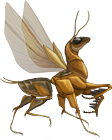 Harvester |
Harvesters supply the hive with food, building materials and other necessary gatherable resources. They have baskets on their back and middle legs that they use to collect liquids and bulk materials. The front legs are equipped with applanate "claws" that they use for digging and grinding. | Not breedable. Grade 1. Careful. Negative genes do not give you negative maneuvers on the battlefield. The amount of resources found on islands is increased by +30%. Grade 2. Grade 1 bonuses. Grade 3. Grade 1 and Grade 2 bonuses. |
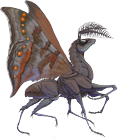 Scout |
This morph is specialized for exploring and moves with perfect silence. It has big feathery antennae and its body edges is covered with soft fur-like sensitive bristles to perceive the slightest mechanical and chemical stimuli. Scouts are mostly nocturnal but this doesn’t mean that they are helpless at the daylight. They just don’t like the abundance of information that is gathered by their perfect senses at that time. | Not breedable. Grade 1. Silent Pace. Critical Strike chance is increased by 30%. First strike is always a Critical Strike. Your pet has Sense of Direction ability. You have Sneak Attack and additional Move maneuver on the battlefield. Grade 2. Grade 1 bonuses. Grade 3. Grade 1 and Grade 2 bonuses. |
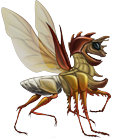 Defender |
Defenders are the main power that is responsible for the safety of the Hive and usually they stay at a short distance from it. Their main task is to deter the enemy until the Workers will evacuate the larvae and eggs and all the other morphs will come to help repelling off the attack. The exoskeleton of Defenders is thicker and harder than that of the other morphs. Their chitin forms the extruding plates that can easily stop an attacker and trap his limbs between the plates. Their rear wings are protected with thickened and hardened front wings to avoid the damaging of their flight apparatus. | Not breedable. Grade 1. Hardened chitin. Constitution is increased by 50%. You have additional* Defense maneuver on the battlefield. Grade 2. Grade 1 bonuses. Grade 3. Grade 1 and Grade 2 bonuses. |
*Additional maneuvers here mean that your pet does not need to have 100+ maneuver-specific stat in order to get a second maneuver of the same type. It won't receive a third maneuver after increasing this stat to the required threshold.
Breeding and pheromones
- Warrior - win 50 battles on Arena
- Scout - visit 20 islands in Explore
- Defender - lose 50 battles on Arena
- Harvester - gather 1000 resource units in Explore
A Worker can produce only one pheromone of each type for his whole life.
Workers receive a signal from a female whe she becomes pregnant. They take her egg to the hatchery and start to care about it. If they want to raise a specialized morph, one or several Workers with ready pheromones are staying near the egg and then the larva until it becomes mature.
You can assign 1-3 Workers with ready pheromones to a pregnant female. The more Workers you assign, the higher grade will receive the morph after metamorphosis. The maximum grade is 3. You can change your mind and cancel this baby-sitting or change to the other type of pheromone until the moment of birth. After this you can't modify the chosen pheromone and cancel the brood caring for the baby-sitting Workers until the larva grows up.
Tactics
Throdama Defenders with Plates gene have a new defensive maneuver - Plates. It scores 2 points even for the attack maneuvers that ignore normal defence. Defence maneuvers can't score more points than opponent's attack points. Defence won't score any ponts if the opponent didn't attack.
The squad containing 4 Harvesters gets Locust ability. Locust gets instant bonus from the minor zones (The Crimson Tree, The Ancient Battlefield and The Old Mine) collecting the Vermillion and the silver once they take the zone.
The squad containing 4 Warriors with Stench gets Stinking Cloud ability. The foul cloud around the squad is so strong that an enemy squad gets an out-of-turn maximum discipline degradation right before the battle.

